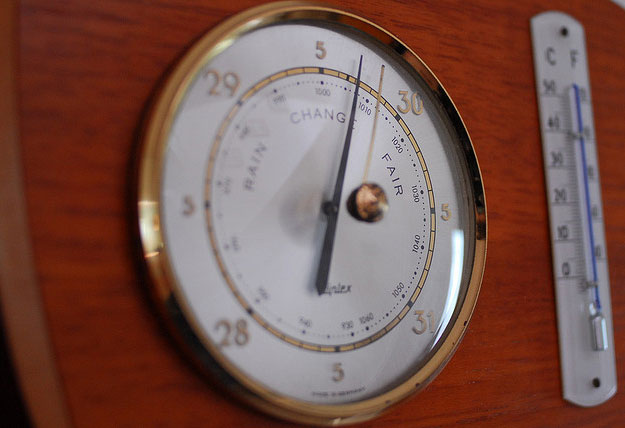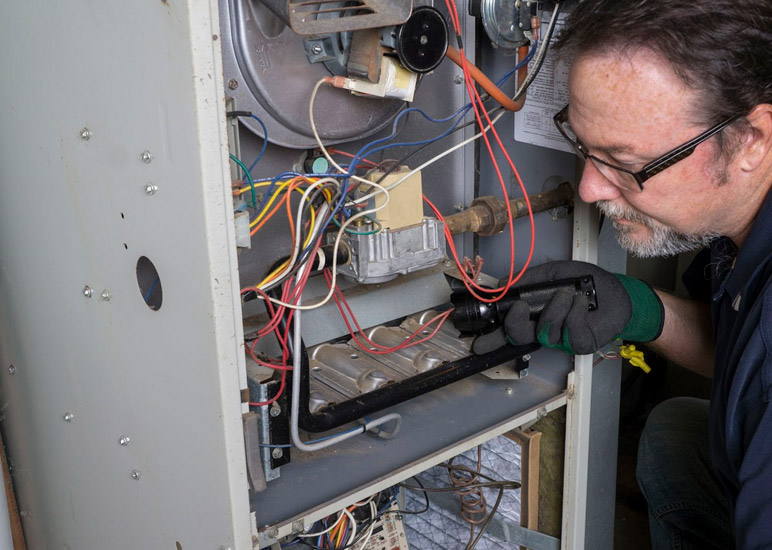
https://www.flickr.com/photos/davidchief/
It has been a commonly discussed topic over the years – does running a furnace cause low indoor humidity in the winter? We’re here to explore this topic with you and hopefully dispel some common misconceptions about dry air, humidity levels, and your furnace this winter. We’ll also offer some alternative causes for low indoor humidity and what you might do to increase your home’s humidity and keep it at a comfortable level.
Dry Air, Humidity Levels, and Relative Humidity
Let’s first discuss humidity levels in your home and the idea of relative humidity. All that a heater does to your air is warm it up – which is exactly what you want it to do, right? What a furnace doesn’t do is add moisture to the air – but it doesn’t remove moisture, either. What happens with a properly functioning, fully sealed furnace is that your indoor air increases in temperature and the humidity levels remain constant (assuming that no outdoor air is coming in from an open door or window).
However, according to an article published in ASHRAE (the American Society of Heating, Refrigerating, and Air-Conditioning Engineers), what does change is the relative humidity. Because warmer air has the capacity to hold more water vapor, yet your home is experiencing no increase in humidity levels, then the relative humidity does decrease – but without altering the amount of water in your air. Ideally, this should not have any ill effects on your home or your health.
Atmospheric Combustion vs. Sealed Combustion Furnaces
Now we should discuss two different types of common household furnaces and how they might or might not lead to low indoor humidity in your home: atmospheric combustion and sealed combustion furnaces.
An atmospheric combustion furnace pulls air from inside the home and vents it (through the chimney or a cracked window). If your atmospheric combustion furnace is inside your conditioned space (rather than say, an attic, garage, or basem*nt), then you might experience a drafty house – especially if you’ve left a window cracked open (don’t do that!). This is because atmospheric combustion furnaces pull cold outdoor air into your home. For every action there is a reaction, meaning that every cubic foot of air that escapes your home is replaced with an equal amount of new air from outside. Because colder air is also drier, if you are letting outside air into your home, it will case a decrease in your air’s overall humidity. So it isn’t that the air conditioner itself is drying out your air, but that the new air being pulled in is causing the issue of low indoor humidity in winter.
If you place your atmospheric combustion furnace in an unconditioned space of your home, such as a crawl space or the garage, then you do not have to worry about introducing dry air into the living space of your home, or any decrease in humidity.
A sealed combustion furnace pulls air from outside the home and then expels its heating byproducts outdoors. This means that your indoor air is heated without being exchanged with colder outdoor air, and there’s no risk of backdrafts because exhaust gases are vented out a PVC pipe rather than out your chimney. Sealed combustion furnaces are also more highly efficient in comparison to atmospheric combustion furnaces. But the important thing to note is that a sealed combustion furnace shouldn’t result in a decrease in humidity in your home.
If you think your furnace may be the culprit, call a local heating contractor for an inspection.
My Heater isn’t Causing Low Indoor Humidity – What Is and What Can I Do?
We’ve established that if you have a sealed combustion furnace or an atmospheric combustion furnace located in an unconditioned space of your home, your furnace isn’t what is causing the dry air. Yet your hands are dry or you’re experiencing bloody noses more frequently. So what else could it be?
Other possible causes of low indoor humidity in winter:
- Leaky ducts. If your air ducts are not sealed properly, or have just become old and worn, then outside air will leak into your home and cause dry air. This also causes a change in pressure, leading to more infiltration.
- Too much outdoor air. If you’ve gotten into the habit of leaving a door or window cracked in winter, then you are not only allowing fresh air into your home, but fresh cold air into your home. This causes a decrease in moisture, and an increase in the workload for your furnace. Your heating bill will go up and so will the dryness of your home’s air.
- Poorly sealed windows and doors. Old windows and doors don’t have the amount of weatherproofing needed to keep the outdoor air from leaking into your home. This will surely cause cold air to infiltrate your home, leading to low indoor humidity in winter while the furnace runs.
Curious to see how you can increase your indoor humidity this winter? Let our technicians perform an inspection of your home to see if we can help. Call today!
Irish Heating and Air2019-11-26T22:52:55+00:00January 11th, 2016|Heating and Furnaces|
Share This Story, Choose Your Platform!
FacebookTwitterRedditLinkedInTumblrPinterestVkEmail
Related Posts

How Long Should a Furnace Stay Off Between Cycles?
Gallery
How Long Should a Furnace Stay Off Between Cycles?

What Size Generator Do You Need To Run a Furnace?
Gallery
What Size Generator Do You Need To Run a Furnace?

Why Is My Electric Furnace Blowing Cold Air?
Gallery
Why Is My Electric Furnace Blowing Cold Air?

Why Is My Furnace So Loud All of a Sudden?
Gallery
Why Is My Furnace So Loud All of a Sudden?

Why Does My Furnace Smell Like Fish?
Gallery
Why Does My Furnace Smell Like Fish?
As someone deeply entrenched in the world of heating, ventilation, and air conditioning (HVAC), with extensive knowledge gained through years of practical experience and a keen interest in staying abreast of industry developments, I can confidently shed light on the intricate relationship between furnace operation and indoor humidity, a topic that has perplexed many homeowners.
The provided link directs us to an article discussing the impact of furnace operation on indoor humidity levels during winter. Drawing from my expertise, I'll dissect the key concepts presented in the article:
Humidity Levels and Relative Humidity:
The article rightly emphasizes the importance of understanding humidity levels in your home and introduces the concept of relative humidity. It accurately states that a furnace, while efficiently warming the air, neither adds nor removes moisture from it. Instead, the relative humidity may decrease due to the air's increased capacity to hold water vapor when heated.
Atmospheric Combustion vs. Sealed Combustion Furnaces:
The article delves into the distinction between atmospheric combustion and sealed combustion furnaces. Atmospheric combustion furnaces, pulling air from inside the home and venting it, may introduce cold, dry air if located within the conditioned space. On the other hand, sealed combustion furnaces, drawing air from outside and expelling byproducts outdoors, are more efficient and shouldn't contribute to decreased indoor humidity.
Causes of Low Indoor Humidity:
The article identifies potential culprits for low indoor humidity beyond furnace operation. Leaky ducts, allowing outside air to infiltrate, too much outdoor air from open doors or windows, and poorly sealed windows and doors are highlighted as factors that can contribute to dry indoor air.
Solutions for Low Indoor Humidity:
To address low indoor humidity, the article suggests inspecting ducts for leaks, avoiding unnecessary introduction of outdoor air, and ensuring proper sealing of windows and doors. These practical solutions are presented as ways to maintain comfort and avoid the adverse effects of dry indoor air, such as increased heating bills and discomfort.
In conclusion, the article provides valuable insights into the intricate dynamics of furnace operation and its potential impact on indoor humidity. It goes beyond the common misconception that furnaces inherently dry out the air, exploring various factors that can contribute to low humidity levels during winter. As an HVAC enthusiast, I endorse the article's approach of considering multiple variables and offering practical solutions to enhance indoor comfort. If you suspect your furnace is causing low humidity, consulting a local heating contractor for an inspection is a prudent step.